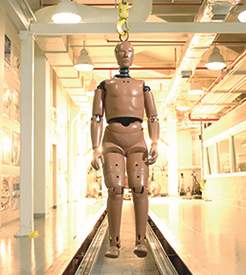Document Type
Article
Publication Date
4-12-2011
Publication Title
SAE International journal of passenger cars. Mechanical systems
Abstract
Formula SAE® is one of several student design competitions organized by SAE International. In the Formula SAE events undergraduate and graduate students are required to conceive, design, fabricate and compete with a small, formula-style, race car. Formula SAE safety rules dictate a 7 m/s (or approximately 15.65 mph) frontal crash test for nose mounted impact attenuators. These rules are outlined in section B3.21 of the Formula SAE rule book. Development and testing methods of these energy absorbing devices have varied widely among teams. This paper uses real world crash sled results to research methods for predicting the performance of aluminum honeycomb impact attenuators that will comply with the Formula SAE standards. However, the resulting models used to predict attenuator performance may also have a variety of useful applications outside of Formula SAE. In this paper, various energy absorbers were mounted to a free rolling trolley sitting on top of a crash sled. The sled was launched so that the trolley with the attached attenuator was allowed to strike a rigid barrier. This resulted in a sudden deceleration measured by accelerometers attached to the trolley. The resulting deceleration from each impact attenuator was then correlated to predicted pulses from theoretical calculations. The lessons learned from extensive testing will be discussed including comparisons between size, shapes, and material properties of energy absorption devices. Additionally, a final theory will be presented describing the ideal way to predict impact attenuator performance. Ultimately it will be shown that, given a known geometry, material properties, and safety factor, the behavior of an impact attenuator can be predicted accurately enough that testing will only be needed as verification. This study will ultimately benefit all Formula SAE® teams, as it will help speed up development time and cut costs, while providing a proven method for creating attenuators that will perform to SAE standards
Volume
4
Issue
1
First Page
836
Last Page
847
DOI
doi: 10.4271/2011-01-1106
ISSN
1946-4002
Rights
© 2011 SAE International, all rights reserved. Posted with permission.
Recommended Citation
Fahland, Jason; Hoff, Craig; and Brelin-Fornari, Janet, "Evaluating Impact Attenuator Performance for a Formula SAE Vehicle" (2011). Crash Safety Center Publications. 8.
https://digitalcommons.kettering.edu/crash_pubs/8


